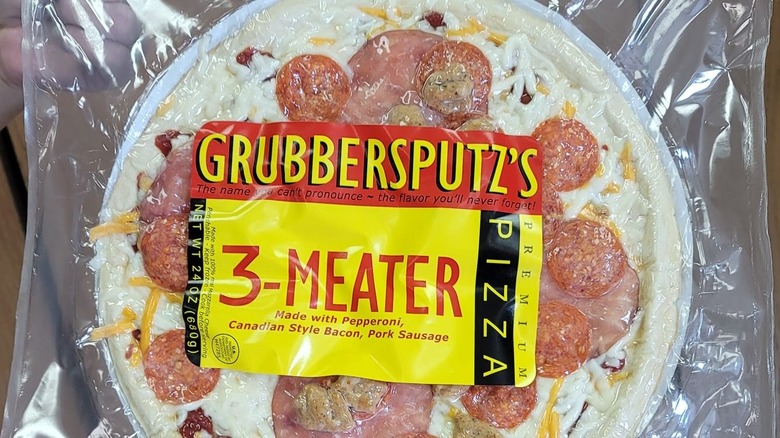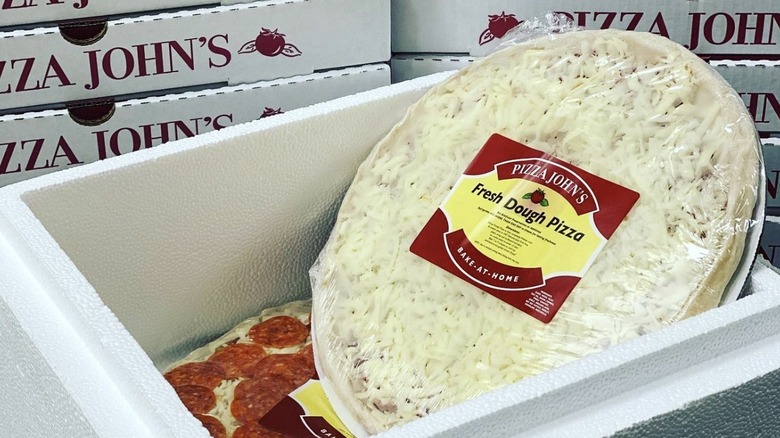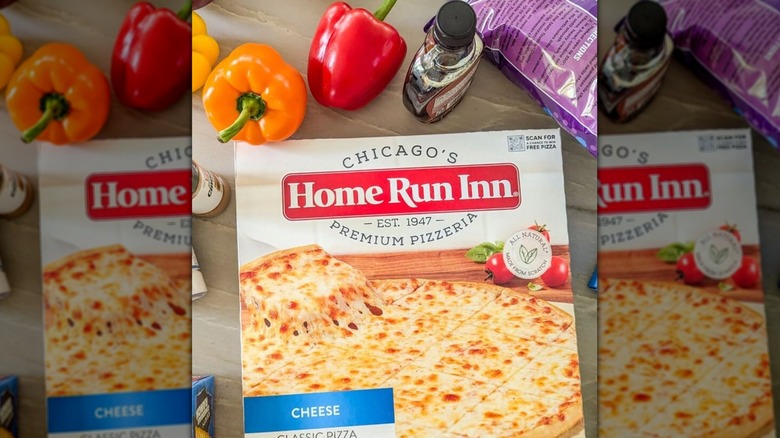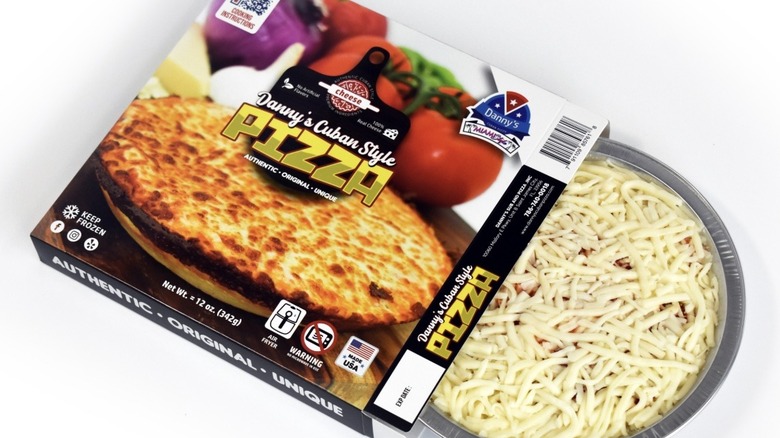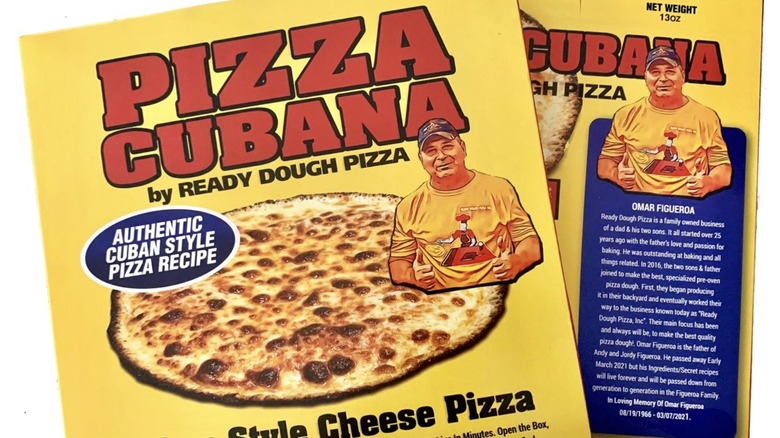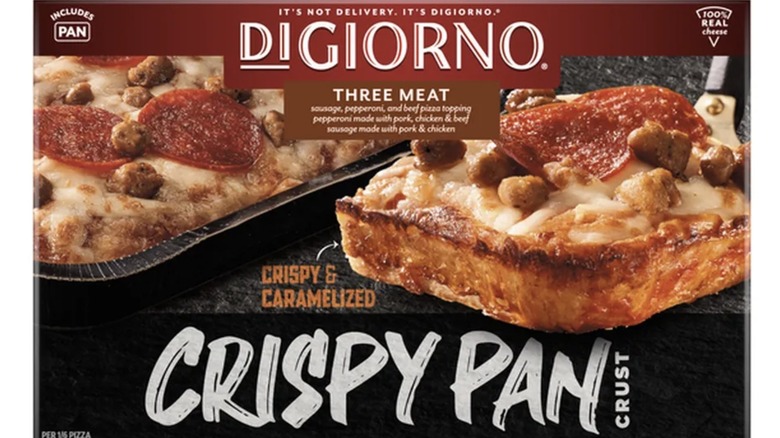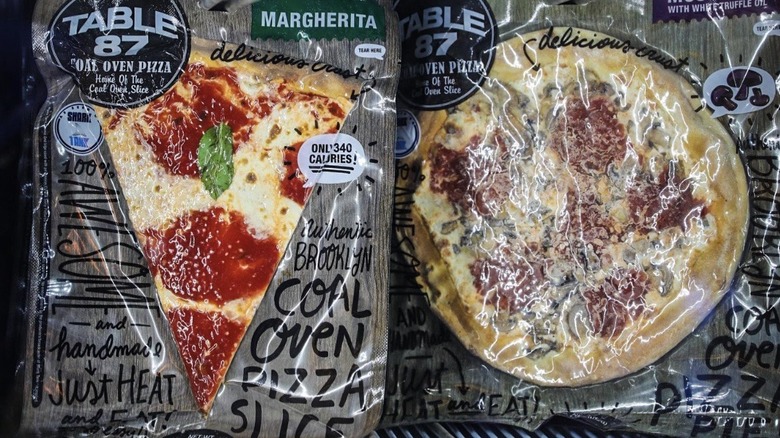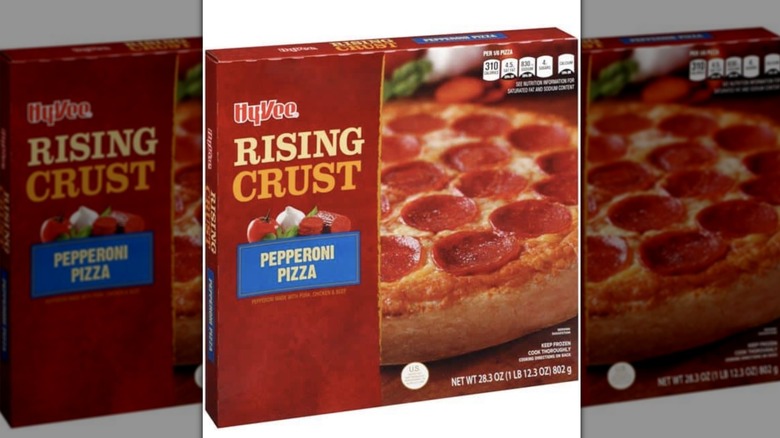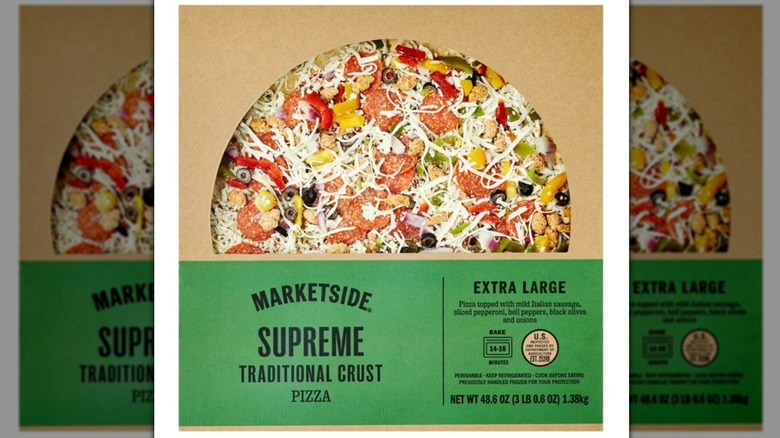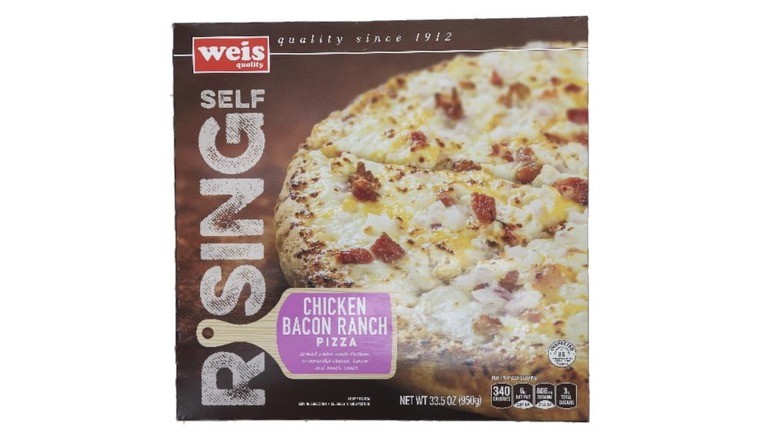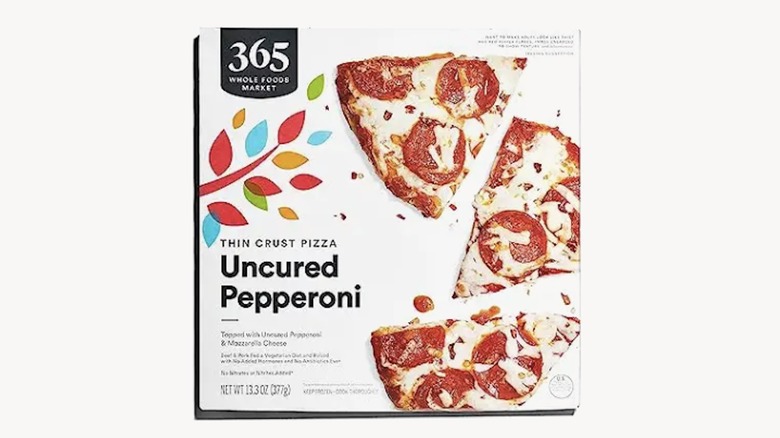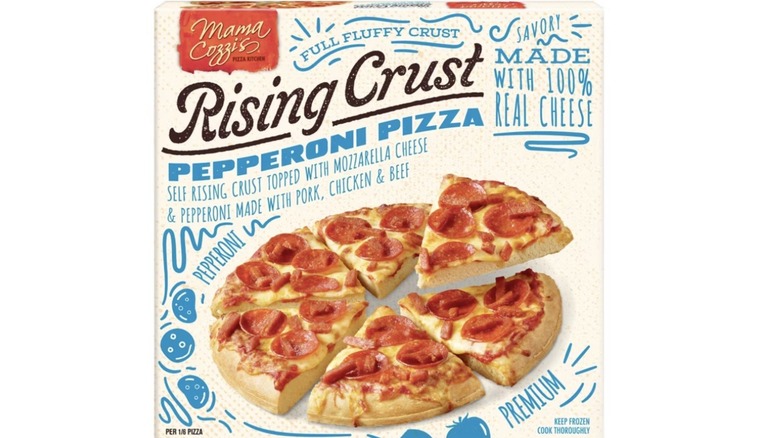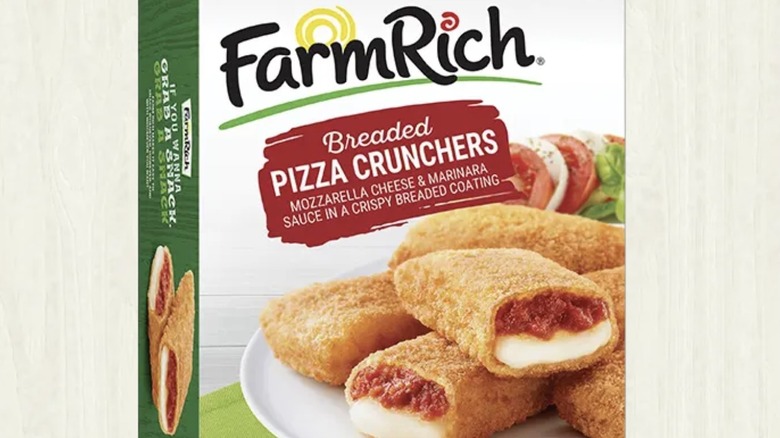15 Frozen Pizza Recalls That Swept Across Grocery Stores
We may receive a commission on purchases made from links.
Though no food can claim to be universally liked, pizza comes as close as anything, meaning recalls are bound to impact large swaths of the population. This is especially true as, in addition to pizzerias serving as a fixture in communities with different types across the country, the plethora of options of readymade frozen pizzas are enough to merit their own section in supermarkets. Just as no two pies can be considered exactly alike, so, too, are no two recalls identical.
Every stage in the production process, from harvesting the ingredients to packaging completed pizzas, is susceptible to risk — as are the steps in getting a slice all the way to your plate. Because of that, strict inspection standards are upheld. But even with those safeguards in place, human error or otherwise happens. As a result, issues with allergens, bacteria, and foreign contaminants are just some of the problems that have led to recalls of pizza shipments from hundreds of pounds up to millions of pounds. It's a shame, considering there are some pretty tasty frozen pizzas out there. These are some of the worst recalls in recent history.
802 VT Frozen (2024)
Merging classic preparation with modern convenience, the VT Pie and Pasta Co. out of Newport, Vermont offers a variety of toppings for its 802 VT Frozen pizzas with crispy wood-fired crusts. While consumers can enjoy a pesto, red pepper, and artichoke pie or a truffled mushroom pizza — and ditch their oven for a cast iron pan to capture the crispiness — it was over 8,200 pounds of the Meat!!! option that was impacted in April 2024 by a recall over an undeclared soy allergen.
Soy poses risks ranging from hives and digestive discomfort to anaphylaxis and death depending on the severity of the allergy. Fortunately in this instance, the U.S. Department of Agriculture's (USDA) Food Safety and Inspection Service (FSIS) had been responsible for discovering the risk rather than an impacted customer. In fact, the agency detailed at the time of the recall of the pizzas produced over the span of an entire year that there had been no confirmed reports of adverse reactions and the undeclared allergen had been discovered thanks to routine checks throughout the production process.
Grubbersputz's pizzas (2023)
As reasons for recalls go, failure to identify an allergen remains a relatively common issue with varied levels of risk. In September 2023, just over 4,000 pounds of Grubbersputz's pizzas were recalled over what was considered a Class II risk by the USDA. The midrange classification, considered a low risk over a "remote probability" of a consumer suffering a reaction, was discovered when FSIS personnel working at the North Dakota production facility had identified the soy content of the pizzas that wasn't detailed on the packaging.
Shipped to stores in Minnesota, Montana, and North Dakota — which ranks top among states for most pizza eaten by volume — the list of the company's pizzas that were part of the recall included a taco style that had tortilla chips and refried beens and a "hog unit" that was topped with Canadian style bacon, regular bacon, BBQ sauce, and jalapeño peppers. Anyone who had purchased the pizzas that was at risk from a soy allergy was advised to discard the pies or bring them back to the store where they were purchased in order to seek a refund.
Pizza John's (2022)
The expression "you don't know what you don't know" can readily be applied to an August 2022 recall when routine surveillance from FSIS uncovered a glaring issue out of Pizza John's Essex, Maryland production facility. The issue was so large in fact that more than 156,000 pounds of bake at home pizza were included in the recall. As to what problem the pies faced, there may have been nothing wrong with them save for the fact that federal inspectors had never checked the products to be certain.
Shipped to stores throughout the Old Line State, roughly 50,000 pepperoni pizzas produced between March 2020 and July 2022 had made it to shelves without a USDA mark of inspection from a facility that itself had not been properly inspected by the agency. Despite the considerable size of the recall and the Class I risk — suggesting a reasonable potential for health hazards — the government detailed that less than 1,500 pounds of pizza had been recovered and no adverse reactions had been filed.
Home Run Inn (2022)
Pizza lovers may disagree over whether a controversial ingredient like pineapple belongs anywhere near mozzarella and tomato sauce, but there are some toppings that no one wants to discover on their pie — like metal. So it was that in August 2022 Home Run Inn Frozen Foods began receiving complaints from consumers that they were finding pieces of an unspecified metal on the company's Chicago's Premium Pizzeria Deluxe Sausage Classic Pizzas.
Though no injuries had been reported, the discovery of the extraneous material impacted nearly 13,100 pounds of pizza that had been produced over the course of two months at a facility in Woodridge, Illinois. To help identify the pizzas, customers were informed of the specific USDA mark of inspection, demonstrating that even under a watchful eye, high risk health hazards could occasionally make it to market. As to how the metal may have made it into the final product, no statement had been provided with the announcement of the recall.
Danny's Cuban Pizza (2022)
Based out of Cape Coral, Danny's Sub and Pizza aims to share the "sabor auténtico" and "estilo único" that southern Florida is known for. However, the "authentic flavor" and "unique style" of the Miami-style pizza ran into a speed bump in July 2022 when varieties of Danny's Cuban Pizza shipped throughout the Sunshine State and Texas became part of a recall over a lack of federal inspection.
Pizzas topped with chorizo, ham, pepperoni, and Hawaiian ingredients produced between January 2020 and July 2022 were part of the 19,275 pounds of product recalled after FSIS determined that the production facility had not been inspected by the USDA. Under the Class I advisory that cautioned consumers about the risk, albeit with no reports of adverse reactions to the pizzas, the recommendation was to discard the product. Those with questions or concerns were provided with a contact number to reach the president of the company, Danny Rodriguez.
Ready Dough Pizza (2022)
For frozen pizzas shipped to Delaware, Florida, and Pennsylvania, it wasn't merely one issue that led to the recall of over four tons of product. Rather, it seemed that the lack of a federal inspection may have contributed to Ready Dough Pizza Inc.'s Cuban-style pizzas making it to retail stores without detailing that three of the nine major food allergens were among the ingredients.
During surveillance activities, FSIS discovered both issues and the recall was announced at just over 8,000 pounds over the inspection issue and the undeclared presence of milk, soy, and wheat. Within a week, an update had detailed an overage on the volume of the recall and lowered the amount to just shy of 6,600 pounds. However, a final correction brought the poundage back to where it started after the federal agency indicated it had determined other types of pizza not originally listed were also included among those that posed a risk for both those with allergies and any possible unknown risk that could present from the products going without inspection.
DiGiorno Crispy Pan Crust (2021)
Unlike the surprise of discovering an onion ring or curly fry in a batch of regular French fries, some consumers weren't delighted to find that their box of DiGiorno Pepperoni Crispy Pan Crust pizza actually contained a three meat pie, instead. In case that weren't enough to ruin a pizza night, it turned out that the frozen alternative included a soy protein, making the error an undeclared Class I risk for those allergic to the ingredient.
After initially learning of the mistake in packaging, the Nestlé USA Inc.-owned brand announced the recall of almost 28,000 pounds of pizza that had been shipped to distribution centers and stores across the country even with a completed USDA inspection. Were someone with a soy allergy to have consumed the three meat pizza without considering the possible risk, the proteins of the legume would cause their immune system to overreact manifesting as a rash, swelling, or even a dangerous decrease in blood pressure.
Table 87
Pizza preferences are about more than debates over deep dish versus thin crust as those familiar with dough disputes have likely heard that New York City water makes all the difference in how a pie tastes. In an effort to deliver a slice of Gotham across the country, Brooklyn's Table 87 began distributing its coal-fired pizza and even leveraged its business with an appearance on ABC's "Shark Tank." Three years later the pizzeria had to recall prosciutto- and pepperoni-topped pies after they went a step further than distributing products without inspection.
The June 2019 recall had begun with 649 pounds of pizza only to be expanded shortly thereafter to an "undetermined amount of frozen pizza" as the FSIS detailed the business had taken it upon itself to apply a mark of inspection without authorization. The USDA was notified of that action after the New York State Department of Agriculture and Markets had reached out to learn whether or not the production facility had undergone the proper inspection.
Hy-Vee (2017)
Soy lecithin may be considered less of a risk than the legume the fat is derived from, but that doesn't mean the USDA treats it casually. In fact, the soy derivative used to improve the final texture of a product was responsible for the recall of almost 18,000 pounds of Hy-Vee pepperoni pizza after an Omaha, Nebraska facility produced the pies without declaring its presence on the packaging.
Thin crust and traditional crust pies alike were subject to the recall after FSIS Inspection Program Personnel (IPP) found the label issue in July 2017. Each case shipped to retail locations across the state of Minnesota was said to have contained four individually wrapped pizzas. In general, the low presence of soy protein in the ingredient decreases the risk for mild allergy sufferers leading this recall to be designated Class II. It remained ill-advised for anyone with a soy allergy to consume the pizza and those impacted were advised to return the pies to the store or throw them away rather than worry about the best methods to reheat any leftovers.
Marketside (2017)
Freezing is not included among the ways to eliminate the potential of a bacterial contamination, so when a concern presented itself in March 2017, the clear course of action for the FSIS was to announce a recall on over 21,000 pounds of pizza. Shipped to distribution centers in California, Nevada, Utah, and Washington, the recall regarded the Marketside Extra Large Supreme Pizzas produced by RBR Meat Company, Inc. at the Vernon, California facility over the possible exposure to listeria monocytogenes.
The bacteria responsible for listeriosis infections warrants a Class I designation as it poses a risk of fatality, especially to infants, the elderly, pregnant women, and those with weakened immune systems. Just because a person doesn't develop symptoms like stiffness, a fever, or gastrointestinal issues immediately after contact with the bacteria doesn't mean they're in the clear. The agency warned that flu-like symptoms could manifest at any time within two months of eating contaminated food.
Weis (2016)
As stringent as the inspection process in the United States is, there remain added levels of screening to ensure that international production facilities aren't shirking their responsibilities to maintain public safety. So, in September 2016 a recall was issued on more than a half a ton of pizza bound for Weis supermarkets after they entered the country from Canada without a re-inspection.
Destined for stores in Maryland, New York, and Pennsylvania, the recall of chicken bacon ranch and pepperoni pizza amounted to 1,250 pounds of product made between March and August 2016. As to how the issue was discovered, an import inspector with FSIS had reviewed the shipments days after the pizza had entered the country leading to confirmation within a week that the pies had never been presented for re-inspection. The risk from a product lacking inspection is similar to theoretical physicist Erwin Schrödinger's famed cat model where the feline was either dead or alive until observed. Instead of considering the potential of either state, the agency opted to believe the risk was real and deemed it Class I.
DiGiorno (2016)
Where production lines intersect, so too does the risk for contamination. So it was that in March 2016 consumer complaints about a foreign contaminant in their food meant a massive recall on both DiGiorno pizza and Stouffers chicken lasagna. Produced at respectively at a facility in Little Chute, Wisconsin and one in Springville, Utah, the Nestlé USA Inc.-owned brands shared a common ingredient as the pizza was a Tuscan-style chicken variety. So it was that they also shared the risk of having small pieces of glass in them after customers had called in with complaints.
Impacting more than 267,000 pounds of food combined, the recall was said to have included product that had undergone inspection by the FSIS. Consumers were advised to make certain about the contents of their freezers as the best by date for the pizzas was August of that year while the lasagnas were said to be good all the way until January 2018.
Whole Foods (2016)
Health risks aren't the only issues at play when it comes to properly identifying ingredients and in January 2016 a recall impacted both the allergy aware and religiously observant alike. Distributed to retail stores and wholesalers across Connecticut, Maine, Massachusetts, New Hampshire, New Jersey, New York, and Rhode Island, almost 74,000 pounds of Whole Foods Markets' pepperoni pizza got recalled because the wrong kind of pepperoni was listed on the packaging.
Instead of containing uncured beef pepperoni like the label stated, the pizzas had been made with uncured pork pepperoni presenting an issue for devout religious practitioners of a number of different faiths. As for safety concerns, anyone with a sensitivity to pork would have been unaware of the other white meat's presence. In explaining how the mixup occurred, FSIS detailed that a new ingredient supplier had been contracted with the Everett, Massachusetts production facility and the agency had discovered the labels had not been properly updated with the change.
Mama Cozzi's Pizza Kitchen (2015)
Produced at a facility in Schaumburg, Illinois, Nation Pizza — a subsidiary of Nestlé USA — ran into an issue with its Mama Cozzi's rising crust pepperoni pizzas in November 2015. Specifically, the frozen pies that had been shipped to Aldi markets in Indiana, Ohio, Pennsylvania, and Tennessee all failed to include a warning that they contained soy. Despite a USDA mark of inspection, nearly 30 tons of pizza were included in the recall.
As to how the issue, considered a low risk by the USDA, had been discovered, FSIS provided an explanation that cited "in-plant review activities" while advising anyone with concerns about health risks to reach out to their doctor. As it was, at the time of the recall there had been no reports of any allergic reactions by consumers who had purchased the pizzas. Having successfully recovered almost 21 tons of the product, FSIS also indicated that it reviews how customers are notified by firms to ensure the effectiveness of recall efforts.
Farm Rich (2013)
Despite the best efforts of inspectors, certain health risks have gone unnoticed until an actual outbreak occurs. So it was in April 2013 when 10.5 million pounds of food had been deemed at risk over a potential E. Coli contamination. Items on the extensive recall from the Buffalo, New York-based Rich Products Corporation included frozen Farm Rich pizzas, pizza slices, pizza dippers, pizzatas, and various sandwiches.
Even after the recall had been announced, the outbreak was said to have expanded to 19 states with no fewer than 35 people reportedly infected by the Shiga toxin-producing bacteria. Among the ill, the vast majority were under the age of 21-years-old, at least seven people had been hospitalized, and two of the infected had reportedly developed a kind of kidney failure known as hemolytic uremic syndrome (HUS). The condition is most common among the elderly and children less than five-years old. By the end of May 2013, the U.S. Centers for Disease Control and Prevention (CDC) considered the outbreak to have ended.



